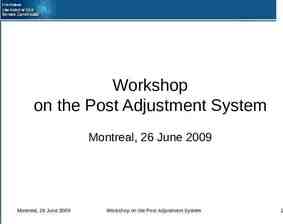1 AND THE INDICATION IS… ACTUARIAL CONSIDERATIONS AROUND RATE
12 Slides636.00 KB

1 AND THE INDICATION IS ACTUARIAL CONSIDERATIONS AROUND RATE CAPPING RPM SEMINAR MARCH 20, 2011 Morgan Bugbee Jeremy Jump Susan Bermender

Antitrust Notice The Casualty Actuarial Society is committed to adhering strictly to the letter and spirit of the antitrust laws. Seminars conducted under the auspices of the CAS are designed solely to provide a forum for the expression of various points of view on topics described in the programs or agendas for such meetings. Under no circumstances shall CAS seminars be used as a means for competing companies or firms to reach any understanding – expressed or implied – that restricts competition or in any way impairs the ability of members to exercise independent business judgment regarding matters affecting competition. It is the responsibility of all seminar participants to be aware of antitrust regulations, to prevent any written or verbal discussions that appear to violate these laws, and to adhere in every respect to the CAS antitrust compliance policy.

Disclaimer 3 The views expressed in this presentation are those of the speaker at this point in time. These views are not necessarily identical to those of the CAS or the speakers’ employers.

Agenda 4 What is Rate Capping? Benefits of Rate Capping Regulatory Perspective Rate Capping Design Rate Indications Under Capping CY Financial Projections Post-Implementation

What Is Rate Capping? 5 Under rate capping, a customer’s renewal rate change may be capped at a maximum percent increase (or decrease) at each renewal until the approved rate level is reached. Example: Current Prem: 1000 Renewal Prem: 1400 Premium at first renewal: 1200 Min( 1400, 1000 x 1.20) Premium at second renewal: 1400 Min ( 1400, 1200 x 1.20) Rate Cap: 20%

Benefits of Rate Capping 6 Customer preference for stable rate changes Improved retention Lower complaint levels Gradual introduction of significant rating plan changes Appropriate new business rates

Regulatory Perspective 7 Some states support capping Some states limit capping Fewer large increases more happy consumers Capping increases okay, but not decreases; and/or Must roll off within defined timeframe (2 yrs) Some states will not approve capping (e.g. CA) Disparate treatment of new and existing customers

Rate Capping Design 8 Capping Structure Cap at a coverage level? Vehicle level? Policy level? Situations to Address Customer Initiated Coverage changes Adding/removing vehicles/drivers Driving activity Moving Discount changes Company Exposure Shift Initiated Subsequent rate Customer aging Model year changes Tiering aging Other Company placement distributional Discovery period shifts changes

9 Rate Indications Under Capping Should indication be based on capped or uncapped premium? Capped Uncapped How much more/less premium you need than you are currently bringing in. How much more/less premium you need than your filed rates. Benefit: Tells you if you’re currently bringing in enough money to cover costs Benefit: Applies directly to filed rates. Drawback: What do you apply the indicated rate change to? Drawback: Doesn’t answer if current income is adequate to on cover costs. based uncapped premium, Indications should be but more analysis is needed

CY Financial Projections 10 Financial projections ensure company is bringing in enough premium to cover costs in near term Must reflect capped premium Requires estimating cap “unwind”, premium trend impact Mismatch with Actuarial projections used in rates requires understanding and explanation

Post-Implementation 11 Actuarial/Product Calculating uncapped premium Calculating on-leveled uncapped premium, both segmented and in aggregate Calculating on-leveled capped premium IT Maintaining capped and uncapped premium in systems Validating and correcting rating errors Customer Communicating to customers why they continue to see increases

12 Questions?






